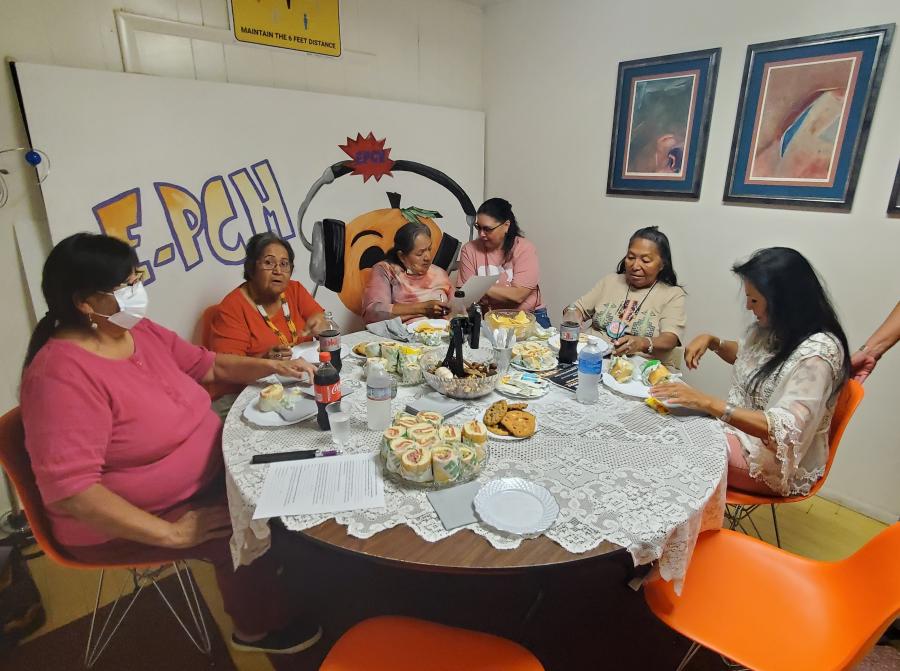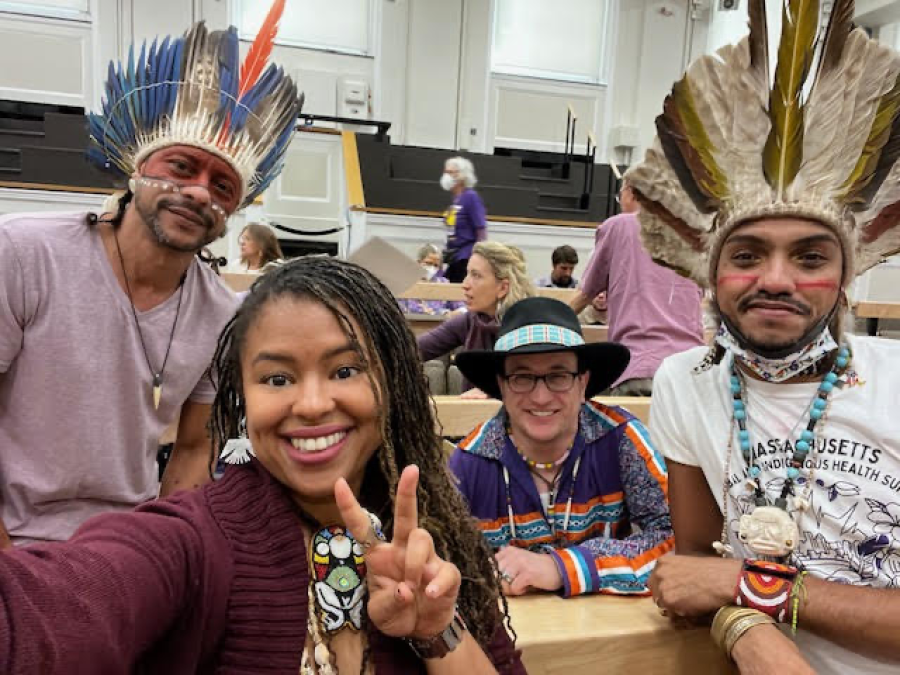
By Tia-Alexi Roberts (Narragansett, CS Staff)
September 27 is World Tourism Day. Though it should be acknowledged that world tourism arguably contributes to some of the most impactful acts of harm towards the environment, it also offers opportunities for education, cultural exchange, and connection.
Cultural Survival recently spoke with T’ata Begay (Choctaw, Chickasaw, Taos Pueblo), a Fancy Dancer who exhibits a passion for sharing the knowledge of her history and culture and for cultivating the Tribal and professional livelihoods of the communities she visits worldwide. She has a Master’s in Education and Policy Analysis from Arizona State University and a B.A. in Human Relations with a minor in Psychology and Native American Studies from the University of Oklahoma. She is currently in the last phase of her doctoral program at Baylor University, where she is an honor student.
Begay was introduced to the powwow arena as a Fancy Shawl Dancer as soon as she could walk. She has been a champion dancer for 30 years, making many friends throughout her travels. She credits dancing with filling her life with happiness and many opportunities like traveling abroad, dancing at WNBA and NCAA games, and performing with country artists Montgomery Gentry and John Anderson. Her dancing was also featured in the television series “Longmire,” among other credits. Despite her busy schedule, Begay makes plenty of time for her husband, Angelo, and their two young sons.
T’ata Begay with her husband, Angelo Begay (Navajo).
Cultural Survival: Please describe your background and how it led you to work in the field of world tourism.
T’ata Begay: I was literally born into it. My entire family are powwow dancers, a gift and whole life that we hold on to very proudly. My parents used to travel overseas with an international dance troupe called the American Indian Dance Theater, as well as with the US government, visiting different military bases and providing a feeling of home with our Indigenous songs and dances. One of the most enriching aspects of performing on stage is educating [the audience] on the songs and dances, explaining that we are not just hollering and jumping around. We share stories, prayers, and good feelings with our songs and dances. We are competitive powwow dancers as well. On any given weekend you’ll find us in our home state or 20 hours away on the other side of the country dancing and sharing our dance styles.
CS: How has your education prepared you for addressing the challenges and opportunities within world tourism?
TB: What a fun question! My educational history has made its way full circle in everything I’ve done professionally. My knowledge of psychology and human relations has definitely given me the upper hand in learning how to communicate with others; it is acknowledging body language and tone and talking accordingly for the audience to understand. Then, of course, my experience specifically within the field of education has allowed me to help others learn in a way that is comprehensive and understanding, especially when talking about Indigenous issues. I am a huge advocate for advocating for authentic stories and challenging the misconceptions and stereotypes of Indigenous people created by non-Indigenous people. If we can teach while entertaining, staying active, and having fun, I see it as a win all the way around.
CS: What inspired you to focus on the impact of tourism on Indigenous communities in your career?
TB: Since I could remember, I was always the little Indigenous kid in my class being called out to “chant,” “dance around the fire,” or “play ‘Indian,’” because everyone knew I sang and danced powwow, but they didn’t really know what that meant. As I got older, [I saw that] American and Oklahoma state history books spoke of my people as if we were extinct. Then in university, everyone was still getting it wrong to where I would literally cringe in class at what was being taught. In my ‘weekend life,’ I am surrounded by hundreds of Indigenous people from at least a hundred or so different Tribes. I’ve traveled to so many beautiful Indigenous lands and communities and heard so many lively and thriving stories of our growth as Indigenous people that I choose to showcase our resiliency and use my gift of catching the viewer's eye with our powwow songs and dances, but also getting the attention of their ears and hearts by educating with our stories and personal experiences.
CS: What strategies do you employ to ensure that tourism initiatives you are involved in are respectful of Indigenous cultures and practices?
TB: I think if anything, I bring perspective to the table. When educating about Indigenous people, it also needs to be relevant to the audience. Therefore, it is always finding a way to connect, then educate. I enjoy hooking our audience in and making every performance personal. You cannot have respectful and authentic practices without seeking the experiences and knowledge of Indigenous people. Respect is inclusion and ensuring Indigenous people are brought to the table to provide real-world experiences and expectations for what is appropriate.
CS: How do you integrate your understanding of world tourism trends into your work with Indigenous communities?
TB: At one time, I worked for a Tribal museum where it was my job to teach about one of my Tribes. My traveling experiences allowed me to see how other Tribes were sharing their version of authenticity and how they were teaching others in their respective Tribal areas. History and culture are not everyone’s jam, but if it can be done in an entertaining way, positive strides can be made.
CS: What role does research play in your approach to tourism, particularly in relation to Indigenous issues?
TB: I believe if you are not researching the location you are visiting, the audience you will perform in front of, and the expectations of [the employer], then you are missing out on a huge opportunity to dismantle Indigenous misconceptions and share some well-deserved truths. There is [also] always room for educational reciprocity—not just educating others, but also learning from others.
CS: How do you balance the economic benefits of tourism with the need to preserve Indigenous cultural integrity?
TB: I believe it goes back to authenticity. Suppose you, as an Indigenous person, are abiding by the traditional ways and sharing what is appropriate and not abiding by the Eurocentric mainstream expectations. I see nothing wrong with contributing to both.
CS: Looking forward, how do you plan to apply your degree and expertise to shape the future of tourism in a way that benefits Indigenous communities?
TB: I plan to develop a framework to help other Tribal/ethnic groups interested in establishing a museum to consider how authenticity can be represented. Unfortunately, I think updating Indigenous topics within the public schools is a lost cause because of politics. However, what is within our control is what we choose to share within our spaces as we see fit: the good, the bad, and the ugly.
Traveling the world offers many opportunities to grow, learn, experience culture, and meet new people. Perhaps prior to traveling, planning to have a more environmentally friendly trip and doing a quick research on the climate change issues in that area could help mitigate these challenges. Some solutions could include supporting a Native-owned business, practicing food conservation, using less transportation, not traveling to specific areas, and going plastic-free. Ultimately, having an eco-friendly trip while learning about the culture and people of that territory can be one of the best ways to travel.
Top photo T’ata Begay dancing the Fancy Shawl Dance. Photo courtesy of Dan Gooden.



